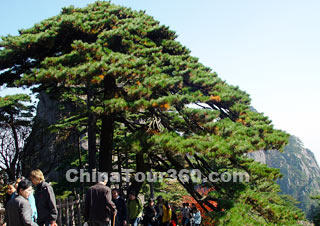 Unique Rocks and Pines
Unique Rocks and Pines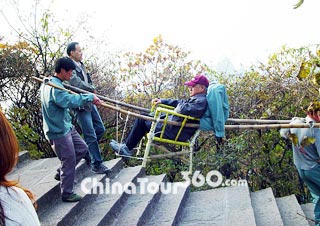 Sedan Chair on Mt. Huangshan
Sedan Chair on Mt. Huangshan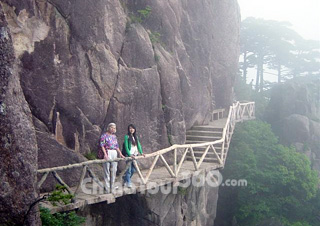 Huangshan Grand Canyon
Huangshan Grand Canyon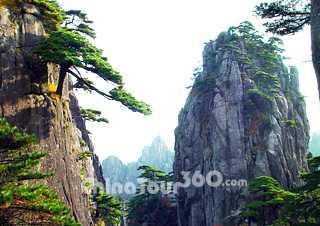 Huangshan Mountain, Anhui
Huangshan Mountain, Anhui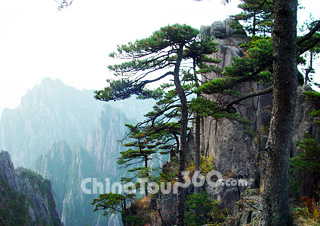 Beautiful Scenery in Huangshan
Beautiful Scenery in Huangshan
Mount Huangshan occupies a very unique position in Chinese history and culture. It has been considered to be with the most beautiful mountain scenery.
It is standing in southern Anhui Province. It was named Mt. Yishan in ancient times. According to the legend, the ancestor of Chinese people, Huang Di researched the alchemy here and became an immortal at last. People named it Mount Huangshan in the Tang Dynasty (618 - 907) to commemorate Huang Di.
Varied peaks converge on the mountain, of which seventy-seven have names. Thirty-six of them are bigger, lofty and sheer; while the other thirty-six peaks are small, steep and beautiful. On every peak, stones there have taken on a variety of shapes.
Besides craggy peaks and jagged stones, pines on this mountain are also very famous. No matter on the cliff or summit, green pines stand everywhere. The pines have curving trunks and branches, plat top and short and thick needle viridian leaves. There is no soil on stones on the cliff, so pines stick their roots deeply in stone seams and rely on the soil in the crevices. Those pine trees on the mountain, growing firmly with dignity and defying storm, heavy snow and severe cold, show very powerful vitality and strength. Tourists are not only attracted by the charming scenery of pine trees, but also moved by the spirit on these trees. In Chinese culture, Mt. Huangshan pines have become synonymies of 'tenacity' and 'pertinacity'.
If stones and pines are flesh and blood of Mt. Huangshan, then the sea of clouds are the temperament and charm of the mountain. When clouds and mists rise, the main peak is gradually cloaked by white sea of clouds, only the lofty top stands above the clouds. When wind blows to move clouds, the mountain peaks, near and far, are veiled for a while and reappear again. This gives visitors a feeling of being in fairyland. Especially at sunrise and sunset, multicolored sea of clouds is very spectacular.
The mountain is a combination of all kinds of attractive beauty of other mountains: craggy peaks and jagged stones are majestic; pine trees and waterfalls are graceful and clear; sea of clouds is mysterious and romantic. The well known Chinese traveler of Ming Dynasty (1368 - 1644) Xu Xiake wrote a famous poem for the mountain: no need to visit other mountains after you visit the Five Sacred Mountains and no need to visit the five after you visit Mt. Huangshan.
The scenery of the mountain aroused many previous poets' and painters' inspiration. According to an incomplete statistics, from the glorious Tang Dynasty to the late Qing Dynasty (1644 - 1911), there were more that 20,000 poems to praise Mt. Huangshan during these 1,200 years. In the field of painting, the scenery of the mountain has impacted significantly on the development of traditional Chinese landscape painting. At one time a new school of painting was formed by taking Mt. Huangshan as the theme, which is called Huangshan schools of painting.
Nowadays Mt. Huangshan is one of China's most popular tourist attractions. It was listed by UNESCO as a World Cultural Heritage Site in 1990.
![]() Tickets: (kids under 1.1 m are free of all charges)
Tickets: (kids under 1.1 m are free of all charges)
Entrance Fee:
CNY 230 (Mar. to Nov.); CNY 150 (Dec. to Feb.)
Cable Car:
CNY 80 for adults, CNY 40 for kids between 1.1 - 1.3 m (Mar. to Nov.)
CNY 65 for adults, CNY 35 for kids between 1.1 -1.3 m (Dec. to Feb.)
![]() Transportation: Take the bus directly to Huangshan Scenic Area at Huangshan Railway Station.
Transportation: Take the bus directly to Huangshan Scenic Area at Huangshan Railway Station.







